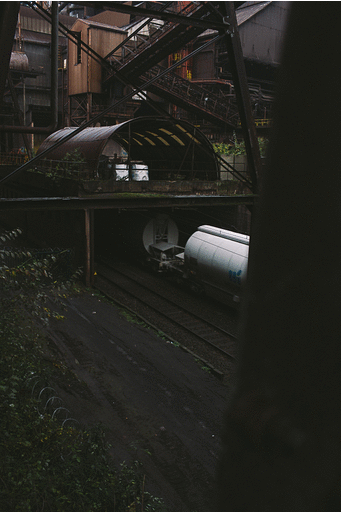It has been some since I crossed the channel or continents to see some of the incredible variety of delights that lay there. This is a roundup of some of the places I visited on a speedy weekend jaunt at the start of November.
6 months in the planning with a extreme (bordering on unhealthy) amount of research done and some help from close friends meant that there was a prime selection of things that I'd pinpointed to see, centralising primarily, as usual, around heavy industry in Belgium & Germany.
Now, some of the things here were only leads, not having seen photos or knowing what they even were. Most of which I knew "was there" through looking at maps etc... but had absolutely no idea of how to get into them. Perseverance and perhaps a little luck meant that I encountered no problems, which was nice.
The Belgians have a lot of de-centralised power stations, i.e "we've got a big fuckoff factory, it'll be cheaper/more efficient to build our own than take from the grid" This one in particular was not as abandoned as first thought... with its turbine at idle and hissing steam pipes it was absolutely boiling and extremely noisy.


Bedding down in a layby (that appeared quiet in the middle of the night) I was awoken by quarry trucks thundering past my head… onwards to a cafe filled with Belgians drinking beer for breakfast and a swift coffee and then into one of those half religious / half hospital type buildings they seem to have a fondness for in Belgium.




I then headed towards the industrial heartland of the Meuse valley via a fairly interesting derelict church with a cool bell tower.


And a derelict ex-thermal spa. The entrance hall has an attractive ceiling and there was a fairly nice boiler, although the rest of it was pretty boring and not worth the effort.


The next morning I trundled down some old tracks towards Haut Fourneau B, the smaller and more secure brother of Haut Fourneau 6, which I visited and climbed earlier this year.
Closed in 2011, this Blast Furnace was one of the many elements of the former Cockerill Industrial empire that twisted its way through the Meuse valley from France to Charleroi, Namur, Liege and Seraing joining the Rhine–Meuse–Scheldt Delta in Holland.
The Cockerill family were instrumental in the Belgian Industrial revolution from 1805 onwards with their factories producing spinning engines and steel, steam engines (including air-blowers, traction engines, and engines for ships) and in 1835 Belgium's first steam locomotive.
John Cockerill also had interests in collieries and mines such as those at Ougree, across the Meuse River from HFB / HF6. The Cockerill group, following many different iterations of Cockerill Ougree, Cockerill Sambre, Usinor and Arcelor had their facilities absorbed into the mega Indian/Luxembourg conglomerate Steel giant, ArcelorMittal in 2008. Mittal then helpfully closed this HF6's Blast Furnace in 2009 and this one later in 2011 adding further woes to Eastern Belgium’s already struggling economy leaving Liege’s GDP per capita hovering at some 20k Euros lower than the rest of Belgium’s average.
Liege, Seraing and Ougree are pretty mucky towns, houses are tainted with industrial grime and things look generally a bit knackered. Every now and again the fairly nondescript skyline is punctuated by belching chimneys and structures such as this. Having the view (and smell) of Redcar's Blast Furnace from my bedroom window as a child, these enormous, fiery, rusty majestic structures have always held a certain allure and I spent a wonderful morning climbing and prodding around all manner of things on this enormous site.
It also has a live train line right through the middle - choo choo.

From the top.





Then a powerplant which I’d not seen before, a nice surprise although an intense ballache to get into.



Another find, what I’ve called Salle de Compresseurs as that’s what it was, a compressor hall with a couple of little turbines and localised controls. Brilliantly decayed and again, completely un-molested.



A further powerplant, I’ve struggled to find more than one or two photos of this online. Extremely secure and again requiring a couple of hours of effort to actually get into the turbine hall, it was well worth it to see in the early evening sun.
There are two buildings here, one being the boiler house and the other the turbine hall. The boiler arrangement has flues directly to the roof rather than an external chimney stack with a “loft” housing these enormous concrete clad exhausts.


Turbine hall



Controls.

I bid adieu to Wallonia and headed towards Germany. Having spent a couple of years exploring the Ruhr’s coal mines in 2011 and 2012, I’d got wind of one of the Ruhrpott's last remaining mega mines closing down and had kept tabs on happenings over there.
A couple of photos popped up online and this trip was planned mainly around seeing this… I hooked up with my good friend Pierre (who is actually German despite his name) and headed over. It needed a couple of goes at actually getting on the site past the marauding security gents with their umbrellas and a couple of hours of navigating through pitch black washers and conveyors to see the winding gear (13 stories tall) and the enormous changing Kaue (cage room) but the experiences of seeing these were worth it...






I'll be preparing detailed posts for each of the sites over the coming few weeks so be sure to check back or keep up on twitter as I'll announce them there first.
J.
No comments:
Post a Comment